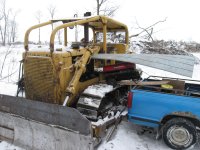If ether is so bad, why does my latest monthly John Deere parts sale mailer have a special price on starting fluid? Did somebody neglect to tell John Deere it will destroy their engines?
Actually here where -20 to -30 F temps are not uncommon we have not used starting fluid on our newer tractors. They are either put to bed for the winter, sit in a heated garage, or have their block heaters plugged in (you get to know how long to heat each one by the outside temp). Many of the loggers around here don't have the luxury of heating out in the woods so they put quick couplers on their pickup coolant lines and on their feller/butchers & skidders and run the hot truck coolant through the machine's engine to warm them for starting. Thinking of that cold blast of coolant coming back into the truck engine at first makes me think of immediate cracked block but they say it is not a problem. Maybe it is that the flow rate is restricted. And like I mentioned before, several of our tractors and combines have an ether starting aid, thermostatically controlled, standard. All you need to do is remember to keep filled cans, the ones that John Deere has on sale in its parts flyer, installed.

